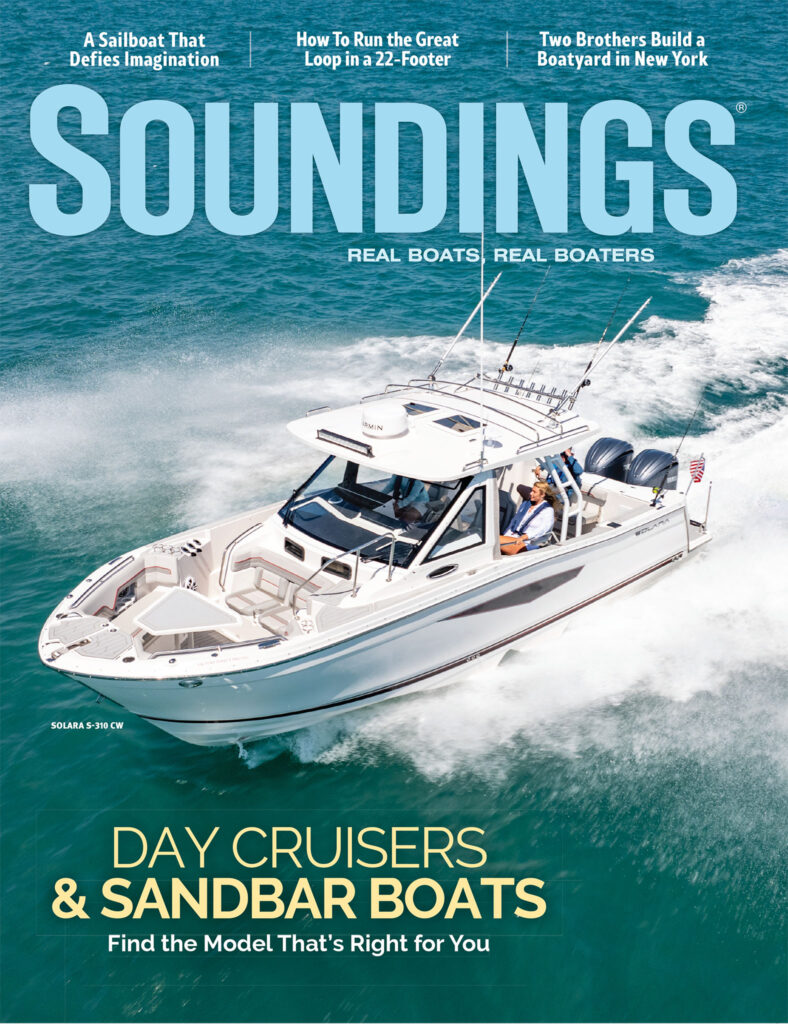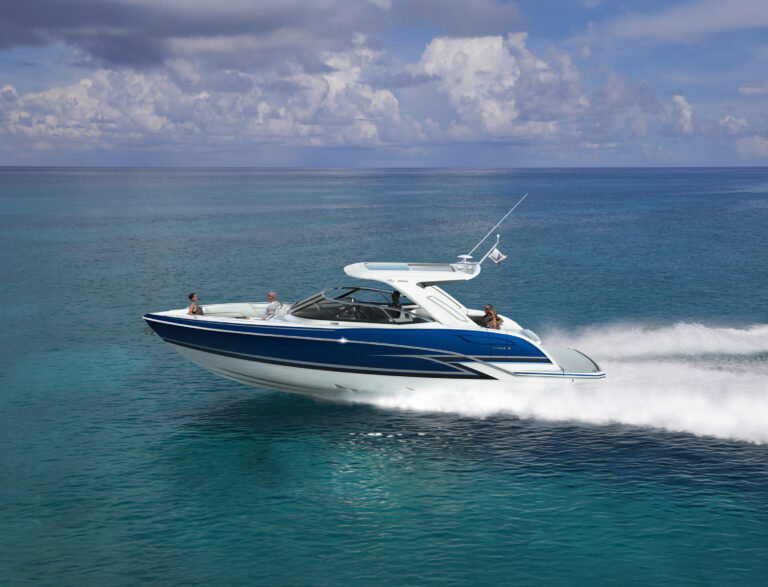A Connecticut shipyard wins a wealthy businessman’s trust and builds a 281-foot superyacht
The 281-foot Cakewalk, launched this summer at Derecktor Shipyard in Bridgeport, Conn., is more than a superyacht. It’s a statement. Cakewalk is “Made in the USA” like Harley-Davidson motorcycles and L.L. Bean’s hunting shoes.

That cachet was one reason the owner built Cakewalk at Derecktor, a U.S. yard with a history of building America’s Cup defenders – Valiant, Mariner, Stars & Stripes and USA-11. The yard has built yachts drawn by such famed designers as Sparkman & Stephens, John Alden and Phil Rhodes. It has built a flotilla of tough workboats – high-speed ferries, tugs, and patrol and pilot boats. Now the yard has built a superyacht and it plans to build more.
“We just got back from [the Monaco Yacht Show],” says Capt. Bill Zinser, 58, Cakewalk’s project manager. “There were a lot of people – Russians, Europeans – coming by the Derecktor booth talking about projects.” They liked what they saw in the brochures, he says. They also liked the favorable exchange rate – $1.35 to the euro – to build a yacht in America, he says.
The brief for Cakewalk was to build a northern European-style superyacht at an American yard using northern European techniques and hewing to a northern European – German and Dutch – quality standard, Zinser says. He says the Derecktor yacht exceeds that brief. “In our opinion, the quality is as good as or better than anything we have seen from northern Europe,” says Zinser, who has worked 15 years for this owner and on four of his five yachts named Cakewalk.
Zinser knows the European yards. He oversaw the construction of Cakewalk IV, a 203-footer, at Holland’s Feadship yard, one of the world’s most reputable. He says he pushed Feadship hard to get its best work. “We believe we’ve gone a step beyond our previous boat,” Zinser says.
Cakewalk V is nearly triple the volume of the Cakewalk she replaces. Her owner, an American industrialist who asked to remain anonymous, is an experienced and knowledgeable yachtsman who has owned a number of boats and knows how they’re built, Zinser says.

As they discussed building Cakewalk V, he asked Zinser why American yards don’t win the really big superyacht contracts. Zinser says it’s because wealthy clients don’t think a U.S. yard can handle the jobs. Zinser says his boss set out to prove them wrong.
Derecktor had never built a yacht as big as Cakewalk V. In fact, no American yard has built a private yacht that big since 1930, when Bath Iron Works in Maine launched financier J.P. Morgan’s 343-foot Corsair IV, built for $2.5 million ($32 million in today’s dollars).
Cakewalk’s capacious 2,998 gross tons, spread over six decks, exceeds even Corsair’s 2,142 gross tons, making it the largest private yacht by volume launched from a U.S. yard. With a price tag of well more than $100 million, the yacht – its hull of steel, the superstructure aluminum, the interior finished in wood, wrought ironwork and stone – is in rarefied company. Zinser says a yacht of Cakewalk’s pedigree and quality costs about 30 percent more to build than the run-of-the-mill multimillion-dollar megayacht.
Big though she is, in profile Cakewalk’s six decks don’t convey the look of a floating condo or a starship on steroids, but an elegant yacht. British designer Tim Heywood, in a video interview for Derecktor, says the guidance the Americans gave him was to design a yacht that wasn’t “too aggressively modern.” The result: a “modern classic” whose lines have a traditional feel, although its systems and amenities are very much 21st century.
Heywood says he likes strong lines, a compelling unity and a “female feel with lots of curves” – tasteful, elegant, not overstated – in his yachts. Glistening in the sunlight, the curves in Cakewalk’s deep-blue steel hull are the work of an artist. “It’s a piece of sculpture,” Heywood says.
Step aboard
Guests board Cakewalk through a main saloon styled as a library, with a fireplace, grand piano and cherry finish. The saloon segues forward into a central dining area with a large chandelier and custom-built table that can seat the yacht’s full complement of 12 guests. A spiral staircase amidships connects four of the six decks.
Cakewalk’s six guest suites, each with a head and spa tub, are laid out on the main deck so they can have an oversize window with a view of the water. The owner’s quarters are above the main deck and include a master suite and head, gymnasium, yoga and aerobics studio, spa and a recreation saloon with a theater.
The owner’s quarters are spacious, taking up the entire deck, and include in the master suite a panoramic view forward through a semicircular array of windows, his and her heads with jacuzzis, several lounges and a table for 14 for dining al fresco – on the aft deck.
The bridge deck has a game room, a lounge aft and sunpads on the open forward deck. Above that is the sun deck, which has observation chairs, a whirlpool spa, lounge areas, a bar, card tables and sunpads. The lower deck contains The Boathouse, a 47-by-40-foot tender bay for Cakewalk’s fleet of small boats and water toys.
The flotilla includes a 32-foot limited edition AquaRiva Cento, one of just 10 built by the Italian builder Riva for day cruising; a 35-foot custom Intrepid powered by twin 370-hp Volvo diesels for diving, skiing, wakeboarding and fishing; and a 37-foot Vikal custom “limousine” – Heywood calls it a “seagoing Bentley” – for taxiing guests to the yacht.
Cakewalk’s inventory of fun stuff also includes four WaveRunners, two SeaBob underwater scooters, wetsuits, diving and snorkeling gear, water skis, kneeboards, wakeboards and inflatable water toys.
Designed for the owner’s private use and for charter, Cakewalk carries 25 crewmembers. It can cruise just about anywhere on its steel bottom, but likely will charter mainly in the Caribbean and the Mediterranean unless Zinser’s core of regular charter clients choose to go someplace more exotic, such as the South Pacific, he says. The yacht was scheduled to put in Oct. 28-Nov. 1 at the Fort Lauderdale International Boat Show and then begin chartering in December in the Caribbean.
Powered by twin 3,300-hp MTU diesel engines, Cakewalk cruises on its displacement hull at 15 knots and tops out at 17. Range is 5,000 nautical miles.
Engineering marvel
Derecktor has three locations: a three-acre yard – its headquarters – in Mamaroneck, N.Y., that builds and services pleasure, military and commercial craft and racing yachts; a 17-acre repair yard in Dania, Fla., that caters to sail and power yachts; and the 23-acre Bridgeport site, which opened in 2001 as its big-boat yard, repairing and building commercial vessels and yachts to 400 feet.
Zinser says he and the owner liked Derecktor for its commercial shipyard skills – welders and plumbers and electricians who had worked on 270-foot Coast Guard cutters – and for its finish craftsmen, who build and refit high-end yachts. They also knew Derecktor’s work firsthand, having undertaken an 18-month refit of a 142-footer, another Cakewalk, at its Dania yard.
Though American-made, Cakewalk V is an international effort, as these yachts usually are, Zinser says. They brought in European subcontractors to install some systems – steering and air-conditioning, for instance – and used Heywood to style the boat and a Dutch firm, Azure Naval Architects, for the architectural work.
Zinser says one of the distinctive features of Cakewalk’s design is the big tender bay, with its 40-foot-wide electric-hydraulic doors and two overhead sliding crane beams that launch and retrieve the tenders. He says the bay posed an engineering challenge because the framing and bulwarks had to be structurally reinforced to meet Lloyd’s Register classification standards so that if the doors were blown open under way the bay could stand up to flooding seas.
Housing the guests on the main deck far from the engine and other operating systems is another special feature. “They have the best area of the boat,” he says. “They will barely hear us get under way. The specifications for the sound and vibration on Cakewalk were very tight.”
The yacht also has lots of open-air space on each deck for guests to lounge. “People like to be outside,” he says. “It’s got big, wide side decks, huge aft decks, lots of places to sit.”
Though refined and elegant, Cakewalk is a tough passagemaker. “She’s a seaworthy boat that looks beautiful,” Zinser says. “She can go anywhere.”
See related story:
This article originally appeared in the December 2010 issue.










